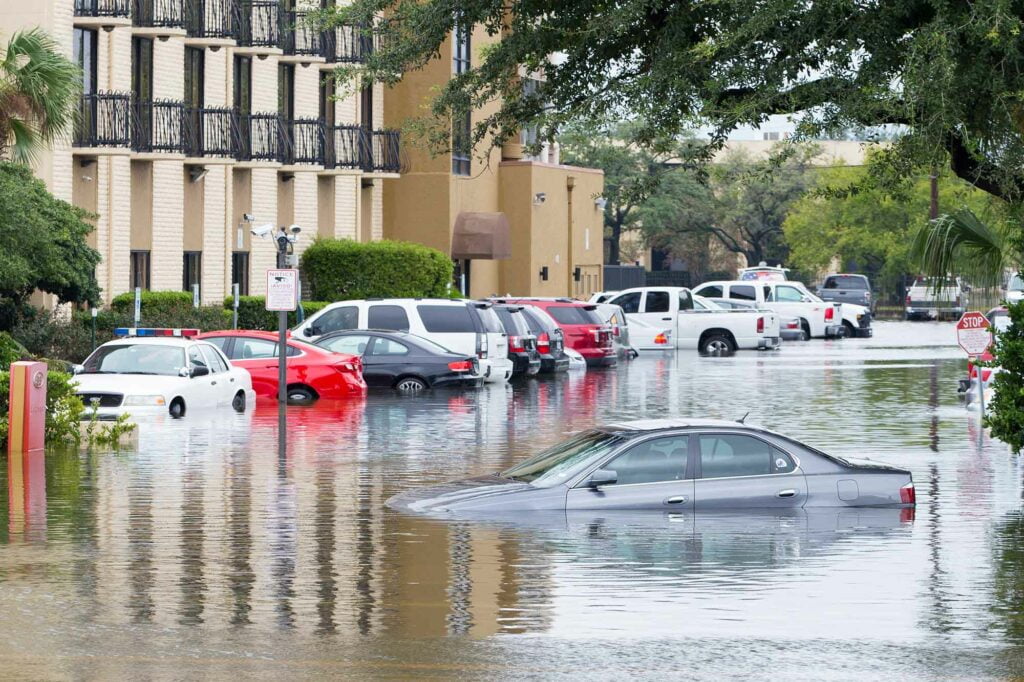Areas that experience heavy rainfall, snowmelt, and tropical storms are susceptible to flash floods. If weather conditions are favorable for a flash flood in your area, the National Weather Service issues a flash flood watch to give you time to prepare. These typically are issued up to 48 hours before flooding is expected.
Although a flash flood won’t always occur, preparing ahead of time is crucial to protect life and property if it does. Keep reading to learn more about flash floods and some safety tips.
What is a Flash Flood?
A flash flood describes a sudden flood of fast-moving water, typically in low-lying areas where runoff from surrounding land collects. They are most commonly caused by heavy rain in a short period, although non-weather events can trigger a flash flood. Unlike a typical flood, flash floods take minutes to develop instead of hours or days and require immediate action. If your area is under a flash flood warning, it’s time to head to higher ground now, if possible. Stay out of the water if you can, and call for help if you are stuck in flash flooding.
There are several causes of flash floods, including:
- Torrential rain
- Melted snow or ice
- Ice jams in rivers
- Dam failure
- Severe thunderstorm
Severe weather conditions that involve heavy precipitation are the primary drivers of flash floods. However, dam failures and ice jams are two other significant sources of flash floods, although far less common. While river flooding is not likely, secondary creeks and streams are especially prone to flash flooding.
What is a Flash Flood Watch?
A flash flood watch is issued when weather conditions favor flash flooding. This does not mean you will experience a flash flood, but the risk of a flash flood is elevated.
The National Weather Service issues flash flood watches to give residents living in those areas extra time to prepare. Issuing a flash flood watch provides critical information to locals to take steps to ensure their safety and minimize damages. These are broadcasted over local radio, TV, and NOAA weather radio stations. It is a good idea to keep an eye on media broadcasts so that you can take action the moment a warning is issued.
What is a Flash Flood Warning?
A flash flood warning means a flash flood is imminent or occurring. You must take action right away to protect your life and property. Flash floods travel rapidly through low-lying areas, so there is little time to devise an effective plan. This is why we recommend you develop a plan ahead of time so you know what to do if a flash flood occurs.
There are a few common sense things to follow in a flash flood that will protect you from harm. The most important thing you can do is to stay where you are and wait the storm out. We will talk a little more about this in the next section.

Flood Safety Tips
After a flash flood watch is issued, take preventive measures to keep your family safe and protect your home. In some cases, a flash flood watch may be upgraded to a flash flood warning and require you to move to higher ground. Follow these three tips when a flash flood watch or warning is issued:
- Make a plan and prepare an emergency kit. If a flash flood forces you to evacuate your home, you will need a action plan. Identify safe evacuation routes and avoid flood prone roads.
- Know your surroundings. Floods occur most frequently in areas where runoff collects. Find an alternate route on higher ground to get to your destination.
- Keep track of weather forecasts. Although a flash flood watch only indicates the likelihood of a flash flood, check weather forecasts using a weather radio or your mobile device to stay informed about developing weather conditions and wireless emergency alerts (WEA).
- Move valuables to higher areas of the house. Flash floods pose a risk to you and your family, and your home. To prevent water damage to your valuables, move them to the higher points in your house.
- Do not walk through floodwater. Flood waters can be mixed with all kinds of substances from the road and ground, including sewage. Avoid contact with floodwaters if you can. Still water on the surface also may hide swift currents underneath. You may be swept away.
- Stay in your vehicle if you’re caught in floodwaters. If you are caught in floodwaters, stay in the vehicle as long as possible. The vehicle itself will at least provide protection from debris in the water. If necessary, move to the roof of the vehicle until help arrives.
- Turn around, don’t drown! Never drive through flooded areas. Flood waters may look calm on the surface, but they may be hiding fast-moving water below. It’s also extremely difficult to judge depth.
Flash floods are fast and lethal, so preparing for them is essential to avoid injury and damage to property. Rather than repeatedly checking your phone for warnings, you can use a weather radio to keep you safe and updated on your area’s weather forecasts. Local radio and television is also good source of information if it’s available.
For those looking for a good weather radio, the Midland WR300 is one of the best weather radios that receive Standard SAME and non-weather alerts using a large, easy-to-read display. A personal weather station will also allow you to track rainfall amounts from the comfort and safety of your home.
Wrapping Up
When a flash flood watch is issued, you should take steps to prepare for a flash flood to minimize potential risks and immediate action if a warning is issued. We hope we’ve provided you with a bit more information on flash floods, and we would be happy to answer any questions that you might have regarding these dangerous weather events.


